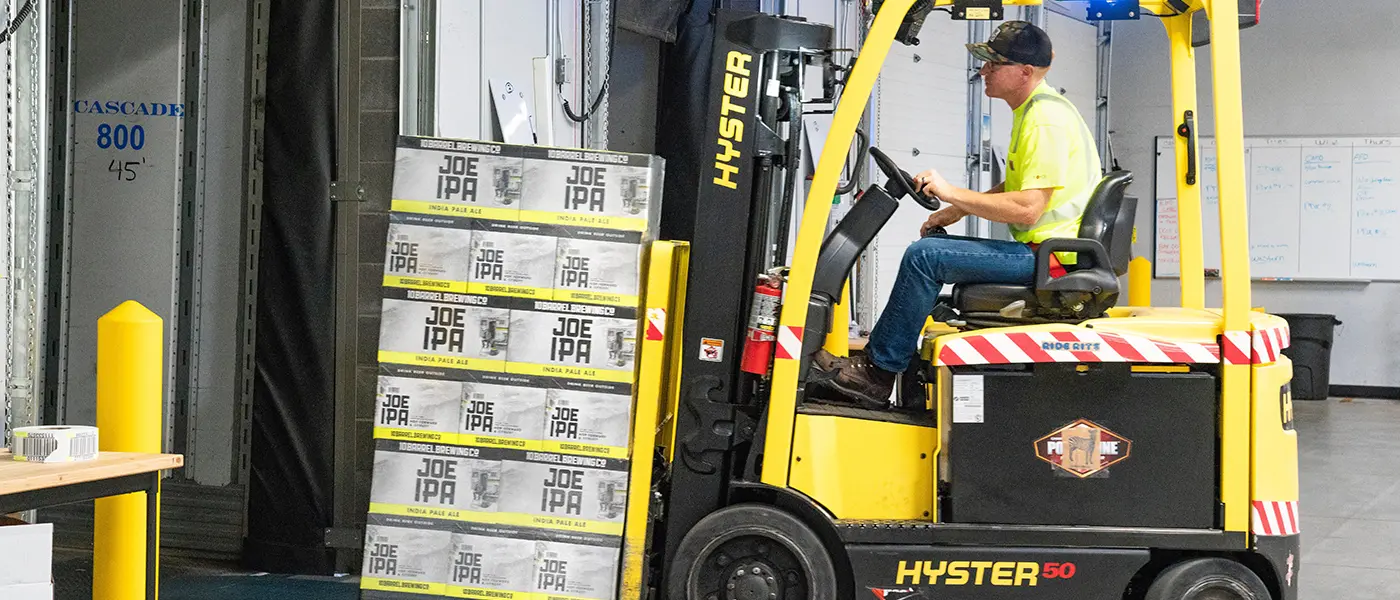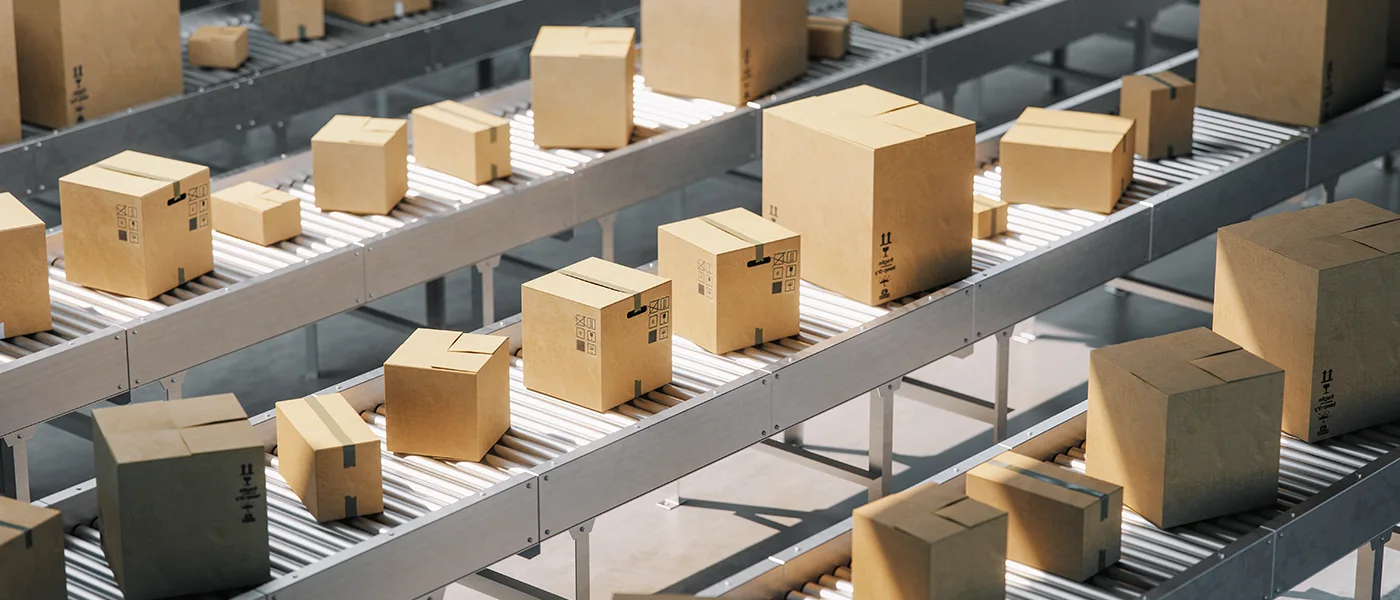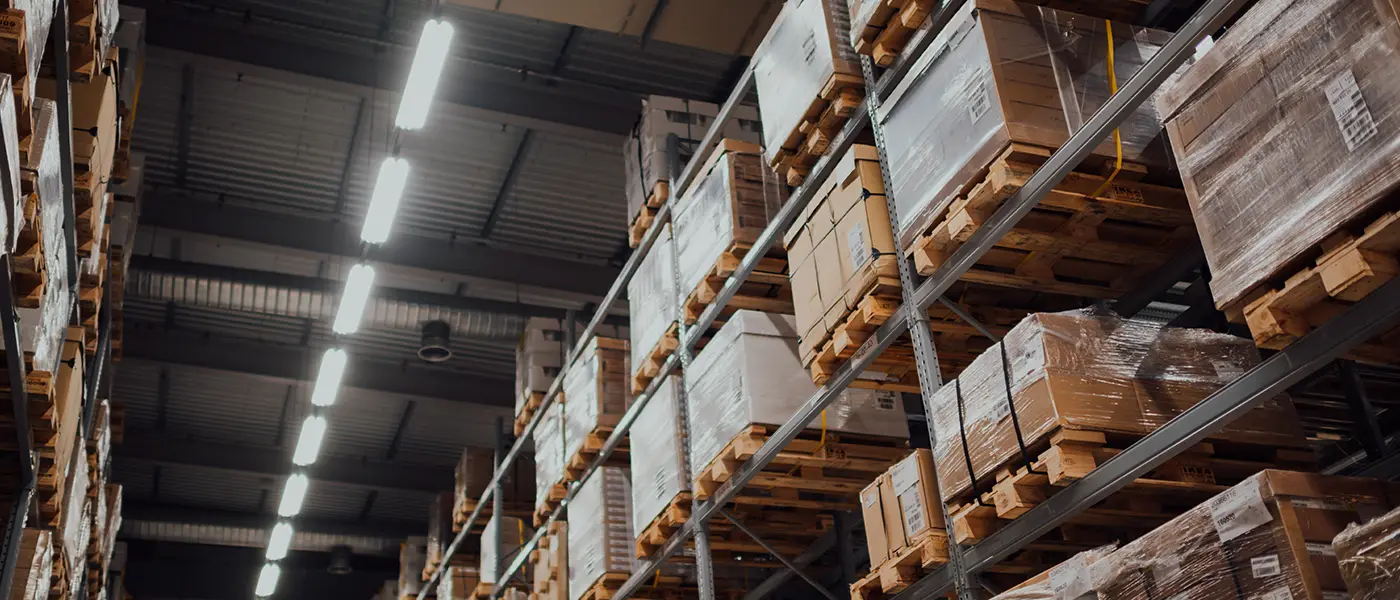Welcome to Locad’s guide on outbound logistics for e-commerce businesses. In this concise resource, we’ll cover the essentials of outbound logistics, share best practices, provide real-life examples, and offer actionable insights to improve your supply chain efficiency.
Whether you’re a seasoned e-commerce entrepreneur or just starting out, this guide will equip you with the knowledge and tools to optimise and upgrade your outbound logistics operations. Let’s jump right in.
What is Outbound Logistics?
Outbound logistics refers to the processes and activities involved in managing the flow of goods from a company’s warehouse or distribution centre to the end destination, which is often the customer. It is a crucial component of the supply chain that focuses on order fulfillment and ensuring the timely delivery of products.
The primary goal of outbound logistics is to efficiently and effectively move products out of the warehouse and into customers’ hands. This includes activities such as order processing, picking and packing, shipping, and transportation management.
In outbound logistics, companies strive to optimise their operations to meet customer expectations and achieve high levels of customer satisfaction. It involves coordinating with various stakeholders, including carriers, freight forwarders, and shipping partners, to ensure smooth and reliable product delivery.
Efficient outbound logistics can reduce lead times, minimise shipping costs, and improve overall customer experience. By streamlining the flow of goods and implementing effective logistics strategies, companies can enhance their competitive edge in the e-commerce landscape.
![E-commerce Outbound Logistics: Definition, Best Practices, Examples & Actionable Insights [+Template] 3 E-commerce Outbound Logistics: Definition, Best Practices, Examples & Actionable Insights [+Template]](https://golocad.com/wp-content/uploads/2023/06/image-5-1024x500.png)
Key Activities in Outbound Logistics Process
The outbound logistics process encompasses several key activities that are essential for the smooth flow of goods from the warehouse to the end destination. Here are the primary activities involved:
Order Processing
Order Processing involves receiving and validating customer orders, verifying product availability, and generating order documentation. It includes tasks such as order entry, confirmation, and status updates.
Picking and Packing
Once an order is received, the next step is to pick the ordered items from the warehouse shelves and pack them securely for shipment. This process requires accuracy, organisation, and attention to detail to ensure the correct products are selected and properly prepared for transit.
Shipping and Transportation Management
After the picking and packing stage, the packages are handed over to the shipping and transportation team. This team is responsible for selecting the appropriate shipping method, coordinating with carriers, arranging transportation, and managing the logistics of getting the packages to their final destinations.
Documentation and Labeling
As part of the outbound logistics process, generating accurate shipping documents, such as shipping labels, invoices, and customs documentation for international shipments, is crucial. Proper documentation ensures compliance with regulations and facilitates smooth customs clearance.
Tracking and Visibility
Throughout the outbound logistics process, maintaining visibility and tracking the movement of shipments is essential. This involves utilizing tracking systems and providing customers with real-time updates on their order status and estimated delivery times.
Customer Communication
Effective communication with customers is vital in outbound logistics. This includes sending order confirmations, shipping notifications, and proactive updates regarding any delays or issues that may arise during delivery.
By carefully managing these key activities, e-commerce businesses can ensure efficient order fulfillment, minimise errors, and provide a seamless customer experience.
Inbound Vs Outbound Logistics: What’s the Main Difference?
Third-party logistics help your business grow by regulating order fulfillment. When you hire a 3PL supply chain company like LOCAD,…
![E-commerce Outbound Logistics: Definition, Best Practices, Examples & Actionable Insights [+Template] 4 E-commerce Outbound Logistics: Definition, Best Practices, Examples & Actionable Insights [+Template]](https://golocad.com/wp-content/uploads/2023/07/Outbound-Logistics-Example-for-SoleStyle-E-commerce-Shoe-Brand-copy-scaled.webp)
Outbound Logistics Example
Let’s take an imaginary example of “SoleStyle,” the e-commerce shoe brand, to understand the outbound logistics process.
- Order processing and fulfillment: When a customer places an order on SoleStyle’s website, the outbound logistics process kicks into gear. The order is received and processed by the fulfillment team. They verify the order details, including the shoe model, size, and quantity, and prepare it for picking and packing.
- Picking and packing: The warehouse staff retrieves the ordered shoes from the designated storage areas based on the order details. They carefully pick the correct shoe models and sizes and pack them securely for shipment. The packaging is designed to protect the shoes during transit and may include additional materials such as bubble wrap or shoe boxes.
- Shipping and transportation: Once the shoes are picked and packed, the outbound logistics team arranges the shipment. They collaborate with shipping carriers or logistics providers to schedule the pickup of the packaged orders. The team ensures the shipping method aligns with the customer’s chosen delivery option and provides the necessary tracking information.
- Documentation and labelling: As part of the outbound logistics process, SoleStyle generates shipping documents and labels for each package. This includes the shipping address, tracking number, and necessary customs documentation for international shipments. Accurate documentation and labelling ensure smooth transit and proper identification of the packages.
- Last-mile delivery: The packages are then handed over to the shipping carrier for last-mile delivery. The carrier is responsible for transporting the shoes from the fulfillment centre to the customers’ doorsteps. Throughout this stage, the logistics team closely monitors the delivery progress and communicates any updates or delays to the customers.
- Customer communication: SoleStyle maintains clear and proactive communication with customers during the outbound logistics process. They send shipping notifications, including tracking information, to keep customers informed about their order status. In case of any issues or delays, the customer support team promptly reaches out to provide assistance and address concerns.
- Returns management: If customers need to return or exchange their shoes, SoleStyle’s outbound logistics team manages the returns process. They provide customers with return instructions, including any required return labels or documentation. Once the returned shoes are received, the team inspects them to determine if they can be restocked or if further processing is necessary.
By efficiently executing these outbound logistics activities, SoleStyle ensures that customers receive their orders accurately and promptly. The streamlined process from order processing to last-mile delivery contributes to customer satisfaction and reinforces the brand’s reputation for reliable and efficient service.
Importance of Outbound Logistics: Why you should optimise it regularly?
Efficient outbound logistics is a crucial component of any successful e-commerce operation. By optimising the outbound logistics process, businesses can reap several important benefits and gain a competitive edge in the market. Let’s explore the significance of optimising outbound logistics in more detail:
- Enhanced Customer Satisfaction: Smooth and timely delivery is key to ensuring customer satisfaction. Businesses can minimise delivery delays, errors, and damaged shipments by streamlining outbound logistics. Customers appreciate receiving their orders promptly and in excellent condition, which leads to positive reviews, repeat purchases, and brand loyalty.
- Cost Reduction: Inefficient outbound logistics can result in unnecessary expenses, such as higher transportation costs, increased product returns, and additional warehousing expenses. By optimising the outbound logistics process, businesses can identify cost-saving opportunities, negotiate better shipping rates, and minimise packaging waste. Improved efficiency also allows for better utilisation of resources, reducing operational costs in the long run.
- Competitive Advantage: In today’s highly competitive e-commerce landscape, providing a seamless and reliable fulfillment experience can set a business apart from its competitors. By optimising outbound logistics, companies can differentiate themselves by offering faster delivery times, flexible shipping options, and transparent tracking systems. This competitive advantage can attract new customers, retain existing ones, and drive overall business growth.
- Supply Chain Visibility: Optimizing outbound logistics provides increased visibility into supply chain management, allowing businesses to track orders, monitor inventory levels, and identify potential bottlenecks. With real-time data and insights, companies can make more informed decisions, proactively address issues, and optimise inventory management. This visibility also enables businesses to align their production and distribution processes better, reducing stockouts and improving overall operational efficiency.
- Scalability and Expansion: A well-optimized outbound logistics system enables businesses to scale their operations effectively. As order volumes increase, efficient processes allow for seamless order processing, fulfillment, and delivery. Businesses can handle higher order volumes without sacrificing speed or quality by investing in scalable logistics solutions and leveraging logistics automation technologies. This scalability is particularly crucial for e-commerce companies aiming to expand their customer base or enter new markets.
- Sustainability and Environmental Responsibility: Optimising outbound logistics can contribute to sustainability efforts and environmental responsibility. Businesses can reduce fuel consumption and carbon emissions by implementing efficient routing and load consolidation strategies. Optimising packaging materials and minimising waste can also minimise the environmental impact of shipping and delivery processes. Emphasising sustainable outbound logistics practices can enhance a brand’s reputation and appeal to environmentally conscious consumers.
- Collaboration and Partnership Opportunities: Efficient outbound logistics often require collaboration with external stakeholders, such as shipping carriers, fulfillment centres, and logistics providers. By optimising the logistics process, businesses can establish strong partnerships, negotiate better service contracts, and access a wider range of shipping options. Collaborative relationships with logistics partners can also lead to shared insights, improved operational processes, and mutual growth opportunities.
Common Challenges of Outbound Logistics
![E-commerce Outbound Logistics: Definition, Best Practices, Examples & Actionable Insights [+Template] 5 E-commerce Outbound Logistics: Definition, Best Practices, Examples & Actionable Insights [+Template]](https://golocad.com/wp-content/uploads/2023/06/image-3-1024x500.png)
Outbound logistics, like any complex process, presents its own challenges that businesses must address to ensure smooth operations and customer satisfaction. Here are some common challenges faced in outbound logistics:
Timely Delivery
One of the primary challenges is ensuring the on-time delivery of orders to customers. Delays in shipping or transportation can lead to customer dissatisfaction and impact the brand’s reputation. Managing and optimising transportation routes and carrier partnerships is crucial to minimise delivery timeframes.
Inventory Management
Maintaining accurate inventory levels can be challenging, especially when dealing with fluctuating demand and multiple e-commerce sales channels. Overstocking or understocking can result in increased costs or missed sales opportunities. Implementing robust inventory management systems and demand forecasting techniques can help optimise optimal stock levels.
Order Accuracy and Fulfillment Errors
Order processing, picking, and packing errors can result in incorrect shipments or missing items. Such mistakes lead to customer complaints, returns, and additional costs. Implementing quality control measures, barcode scanning, and automated picking systems can minimise fulfillment errors.
Warehouse Efficiency
Efficient warehouse operations are crucial for timely order fulfillment. Challenges such as poor warehouse layout, inadequate storage space, and inefficient picking processes can hinder productivity. Implementing warehouse management systems and optimising workflows can enhance efficiency and reduce errors.
Last-Mile Delivery
The last-mile delivery from the fulfillment centre to the customer’s doorstep often poses challenges. Factors like congested urban areas, remote locations, and customer availability can affect delivery efficiency. Leveraging technology solutions, route optimisation software, and effective customer communication can help overcome last-mile challenges.
Returns and Reverse Logistics
Managing returns and reverse logistics can be complex and costly. Efficiently handling returned products, processing refunds or exchanges, and restocking inventory require well-defined processes and effective customer communication.
Customer Expectations
Customers increasingly expect fast, accurate, and flexible delivery options. Meeting these expectations while balancing costs and operational constraints can be challenging. Offering multiple delivery options, proactive communication, and setting realistic expectations can help manage customer expectations effectively.
By understanding and proactively addressing these challenges, businesses can optimise their outbound logistics operations, improve customer satisfaction, and gain a competitive edge in the e-commerce landscape.
Experience fulfillment by Locad today!
![E-commerce Outbound Logistics: Definition, Best Practices, Examples & Actionable Insights [+Template] 6 E-commerce Outbound Logistics: Definition, Best Practices, Examples & Actionable Insights [+Template]](https://golocad.com/wp-content/uploads/2023/07/Best-Practices-for-Optimising-outbound-Logistics-1.webp)
Best Practices for Optimising Outbound Logistics
To achieve efficient and streamlined outbound logistics operations, businesses can implement the following best practices:
- Streamline Order Processing: Implement automated order processing systems to minimise manual errors and reduce processing time. Ensure clear communication channels between sales, fulfillment, and customer service teams to address order-related issues swiftly.
- Embrace Technology Solutions: Utilize warehouse management systems (WMS) and transportation management systems (TMS) to enhance visibility, automate processes, and optimise resource allocation. Barcode scanning, RFID technology, and real-time tracking systems can improve accuracy and traceability.
- Collaborate with Reliable Carriers: Establish partnerships with reliable shipping carriers or logistics providers that offer competitive pricing, on-time delivery, and excellent service quality. Regularly review and assess carrier performance to ensure alignment with your business requirements.
- Optimise Packaging and Labeling: Efficient packaging and accurate labelling reduce the risk of damage and errors during transit. Use appropriate packaging materials and ensure clear and properly affixed labels for smooth handling and delivery.
- Implement Quality Control Measures: Introduce quality control checks at various stages of the outbound logistics process to minimise errors and ensure order accuracy. Conduct random inspections, perform weight checks, and verify product specifications before shipping.
- Adopt Lean Warehousing Principles: Apply lean warehousing principles to optimise warehouse layout, minimise unnecessary movements, and maximise space utilisation. Utilise efficient storage systems, such as bin locations and automated picking technologies, to enhance picking and packing processes.
- Enhance Last-Mile Delivery: Optimise last-mile delivery by leveraging route optimisation software to improve delivery efficiency. Provide customers with flexible delivery options, including time slots and alternate delivery locations, to accommodate their preferences and reduce failed delivery attempts.
- Implement Returns Management Strategies: Develop a well-defined returns management process to handle product returns efficiently. Clearly communicate return policies to customers, streamline inspection and restocking procedures, and focus on prompt resolution to minimise customer dissatisfaction.
- Continuous Performance Evaluation: Regularly monitor and analyse key performance indicators (KPIs) such as order fulfillment time, delivery accuracy, and customer satisfaction. Identify areas for improvement and implement corrective actions to enhance outbound logistics performance.
- Customer Communication and Transparency: Maintain clear and proactive communication with customers throughout the outbound logistics process. To build trust and satisfaction, provide real-time order tracking information, send shipping notifications, and promptly address customer inquiries or concerns.
By implementing these best practices, businesses can optimise their outbound logistics processes, reduce costs, improve delivery efficiency, and enhance overall customer experience.
Logistics Management vs. Supply Chain Management
Logistics and Supply Chain Management are two terms that have frequently interchangeable usage in the business world, but they refer…
![E-commerce Outbound Logistics: Definition, Best Practices, Examples & Actionable Insights [+Template] 7 E-commerce Outbound Logistics: Definition, Best Practices, Examples & Actionable Insights [+Template]](https://golocad.com/wp-content/uploads/2023/07/10-Outbound-Logistics-KPIs-to-Track-for-Optimal-Supply-Chain-Performance-copy-scaled.webp)
Key Performance Indicators (KPIs) for Outbound Logistics
Measuring and tracking logistics key performance indicators (KPIs) is essential for evaluating the effectiveness of outbound logistics processes. By monitoring these metrics, businesses can identify areas of improvement and make data-driven decisions. Here are some important KPIs for outbound logistics:
- Order Fulfillment Time: This KPI measures the time from order placement to shipment. It indicates the speed and efficiency of order processing, picking, packing, and preparation for shipment. A shorter fulfillment time indicates better operational efficiency.
- On-Time Delivery: This KPI tracks the percentage of orders delivered within the promised or expected delivery timeframe. It reflects the reliability and effectiveness of outbound logistics processes, carrier performance, and last-mile delivery operations.
- Delivery Accuracy: This KPI measures the percentage of orders delivered without errors or discrepancies. It considers correct product selection, correct quantities, and adherence to customer specifications. A high delivery accuracy rate demonstrates attention to detail and quality control.
- Perfect Order Rate: This KPI assesses the percentage of orders delivered on time, complete, and without errors or damages. It comprehensively measures outbound logistics performance, encompassing order accuracy, delivery timeliness, and customer satisfaction.
- Return Rate: This KPI tracks the percentage of returned orders relative to the total number of orders shipped. A high return rate may indicate issues with product quality, sizing, or customer dissatisfaction. Monitoring and reducing return rates can help optimise outbound logistics processes and minimise costs.
- Cost per Order: This KPI calculates the average cost incurred to fulfil and deliver each order. It includes packaging materials, transportation expenses, labour costs, and overheads. Monitoring and minimising the cost per order contribute to better cost management and profitability.
- Customer Satisfaction: While not a quantitative metric, customer satisfaction is a crucial indicator of outbound logistics performance. Surveys, feedback, and reviews provide valuable insights into customer experiences, allowing businesses to identify areas for improvement and enhance service quality.
- Backorder Rate: This KPI measures the percentage of orders that cannot be fulfilled immediately due to stockouts or inventory shortages. Tracking the backorder rate helps identify supply chain bottlenecks, inventory management issues, and demand forecasting accuracy.
- Order Cycle Time: This KPI measures the time it takes for an order to complete its entire cycle, from placement to delivery. It includes order processing, picking, packing, transit time, and last-mile delivery. Monitoring order cycle time helps identify process optimisation opportunities and reduce lead times.
- Shipment Tracking Accuracy: This KPI assesses the accuracy of the shipment tracking information provided to customers. It measures the percentage of shipments for which accurate tracking updates are available. Timely and accurate tracking information enhances transparency and customer satisfaction.
By regularly monitoring these KPIs, businesses can identify areas for improvement, set performance benchmarks, and make data-driven decisions to optimise their outbound logistics processes and enhance overall supply chain performance.
Expert Actionable Insights for Improving Outbound Logistics (From Team Locad)
- Implementing Automation: Explore using automation technologies, such as robotic process automation (RPA) or warehouse automation systems, to streamline outbound logistics processes. Automating order processing, inventory management, and packing can improve accuracy, efficiency, and speed.
- Leveraging Data Analytics: Utilize data analytics tools and techniques to gain insights into outbound logistics operations. Analyse data on order volume, delivery times, transportation costs, and customer feedback to identify trends, optimise routes, and make data-driven decisions for process improvement.
- Collaboration with Third-Party Logistics (3PL) Providers: Consider partnering with experienced 3PL providers to leverage their expertise, resources, and network. Collaborating with third-party logistics providers can help optimise transportation management, expand geographical reach, and reduce logistics costs.
- Continuous Training and Skill Development: Invest in training programs and skill development for your logistics team. Enhancing their knowledge of industry best practices, technology solutions, and e-commerce customer service can improve their performance and contribute to a more efficient outbound logistics process.
- Sustainable Logistics Practices: Integrate sustainable practices into your outbound logistics operations. Explore environmentally friendly packaging materials, optimise delivery routes to reduce emissions, and consider partnering with carriers prioritising sustainability. These efforts can enhance your brand’s reputation and contribute to a greener supply chain.
- Proactive Customer Service: Strongly emphasise proactive and responsive customer service throughout the outbound logistics process. Implement customer service tools, such as chatbots or live chat support, to promptly address customer inquiries and concerns. Timely communication and personalised support can enhance the overall customer experience.
- Continuous Process Improvement: Embrace a culture of continuous improvement within your logistics operations. Encourage employees to provide feedback and suggestions for process optimisation. Regularly review and assess the effectiveness of implemented strategies and make necessary adjustments to enhance outbound logistics efficiency further.
- Risk Management and Contingency Planning: Identify potential risks and develop contingency plans to mitigate disruptions in the outbound logistics process. Prepare for unforeseen events, such as natural disasters or transportation strikes, by establishing backup suppliers, alternative shipping routes, and crisis management protocols.
- Integration of Systems and Platforms: Integrate different systems and platforms within your outbound logistics process to enhance coordination and efficiency. Connect your order management system with inventory, warehouse, and transportation management systems for seamless data flow and process automation.
- Customer Feedback and Reviews: Actively seek customer feedback and reviews related to the outbound logistics process. Analyse customer comments and ratings to identify improvement areas and address recurring issues. Utilise this feedback to enhance customer satisfaction and loyalty.
By implementing these actionable insights, e-commerce businesses can optimise their outbound logistics operations, reduce costs, improve delivery efficiency, and enhance overall customer satisfaction.
Connect with Locad, a logistics and fulfillment engine for e-commerce companies in the Asia Pacific region, to leverage our expertise and technology solutions for streamlined inbound, outbound and reverse logistics, improved shipment visibility, and enhanced collaboration with vendors and carriers. Gain actionable insights and optimise your e-commerce operations with Locad’s logistics engine.
Experience fulfillment by Locad today!
FAQs
What is outbound inventory?
Outbound inventory refers to the movement of items from the company’s production line, storage, and finally, to the consumer.
How can outbound logistics be improved?
Outbound logistics can be improved through better inventory and warehouse management and to keep a low cost by maintaining consumer demand.
What are outbound activities?
Outbound activities involve management, selling, and transportation of the finished product to the end customer.
What does outbound delivery mean?
Outbound logistics in delivery refers to the storage, transportation, and delivery of the finished product to customers or other firms.
What are some examples of logistics?
Some of the most common examples of logistics are – Outbound transportation, Order fulfillment, Fleet management, and Order fulfillment.






